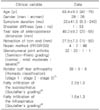|
|
| 1. |
Saupe N, Pfirrmann CW, Schmid MR, Jost B, Werner CM, Zanetti M. Association between rotator cuff abnormalities and reduced acromiohumeral distance. AJR Am J Roentgenol 2006;187:376–382.
|
|
| 2. |
Hartzler RU, Sperling JW, Schleck CD, Cofield RH. Clinical and radiographic factors influencing the results of revision rotator cuff repair. Int J Shoulder Surg 2013;7:41–45.
|
|
| 3. |
Comtet JJ, Auffray Y. Physiology of the elevator muscles of the shoulder. Rev Chir Orthop Reparatrice Appar Mot 1970;56:105–117.
|
|
| 4. |
Goupille P, Anger C, Cotty P, Fouquet B, Soutif D, Valat JP. Value of standard radiographies in the diagnosis of rotator cuff rupture. Rev Rhum Ed Fr 1993;60:440–444.
|
|
| 5. |
Goutallier D, Le Guilloux P, Postel JM, Radier C, Bernageau J, Zilber S. Acromio humeral distance less than six millimeter: its meaning in full-thickness rotator cuff tear. Orthop Traumatol Surg Res 2011;97:246–251.
|
|
| 6. |
Samilson RL, Prieto V. Dislocation arthropathy of the shoulder. J Bone Joint Surg Am 1983;65:456–460.
|
|
| 7. |
Hamada K, Fukuda H, Mikasa M, Kobayashi Y. Roentgenographic findings in massive rotator cuff tears: a long-term observation. Clin Orthop Relat Res 1990;(254):92–96.
|
|
| 8. |
Goutallier D, Postel JM, Bernageau J, Lavau L, Voisin MC. Fatty muscle degeneration in cuff ruptures: pre- and postoperative evaluation by CT scan. Clin Orthop Relat Res 1994;(304):78–83.
|
|
| 9. |
Fuchs B, Weishaupt D, Zanetti M, Hodler J, Gerber C. Fatty degeneration of the muscles of the rotator cuff: assessment by computed tomography versus magnetic resonance imaging. J Shoulder Elbow Surg 1999;8:599–605.
|
|
| 10. |
Werner CM, Conrad SJ, Meyer DC, Keller A, Hodler J, Gerber C. Intermethod agreement and interobserver correlation of radiologic acromiohumeral distance measurements. J Shoulder Elbow Surg 2008;17:237–240.
|
|
| 11. |
Gruber G, Bernhardt GA, Clar H, Zacherl M, Glehr M, Wurnig C. Measurement of the acromiohumeral interval on standardized anteroposterior radiographs: a prospective study of observer variability. J Shoulder Elbow Surg 2010;19:10–13.
|
|
| 12. |
Lehtinen JT, Belt EA, Lyback CO, et al. Subacromial space in the rheumatoid shoulder: a radiographic 15-year follow-up study of 148 shoulders. J Shoulder Elbow Surg 2000;9:183–187.
|
|
| 13. |
Ellman H, Hanker G, Bayer M. Repair of the rotator cuff. End-result study of factors influencing reconstruction. J Bone Joint Surg Am 1986;68:1136–1144.
|
|
| 14. |
Walch G, Marechal E, Maupas J, Liotard JP. Surgical treatment of rotator cuff rupture: prognostic factors. Rev Chir Orthop Reparatrice Appar Mot 1992;78:379–388.
|
|
| 15. |
Chung SW, Kim JY, Kim MH, Kim SH, Oh JH. Arthroscopic repair of massive rotator cuff tears: outcome and analysis of factors associated with healing failure or poor postoperative function. Am J Sports Med 2013;41:1674–1683.
|
|
| 16. |
Kim SJ, Lee IS, Kim SH, Lee WY, Chun YM. Arthroscopic partial repair of irreparable large to massive rotator cuff tears. Arthroscopy 2012;28:761–768.
|
|
| 17. |
Park JY, Lhee SH, Oh KS, Moon SG, Hwang JT. Clinical and ultrasonographic outcomes of arthroscopic suture bridge repair for massive rotator cuff tear. Arthroscopy 2013;29:280–289.
|
|
| 18. |
Jost B, Pfirrmann CW, Gerber C, Switzerland Z. Clinical outcome after structural failure of rotator cuff repairs. J Bone Joint Surg Am 2000;82:304–314.
|
|
| 19. |
Weiner DS, Macnab I. Superior migration of the humeral head. A radiological aid in the diagnosis of tears of the rotator cuff. J Bone Joint Surg Br 1970;52:524–527.
|
|
| 20. |
Nove-Josserand L, Edwards TB, O'Connor DP, Walch G. The acromiohumeral and coracohumeral intervals are abnormal in rotator cuff tears with muscular fatty degeneration. Clin Orthop Relat Res 2005;(433):90–96.
|
|
| 21. |
Wellmann M, Lichtenberg S, da Silva G, Magosch P, Habermeyer P. Results of arthroscopic partial repair of large retracted rotator cuff tears. Arthroscopy 2013;29:1275–1282.
|
|




 ePub
ePub Citation
Citation Print
Print







